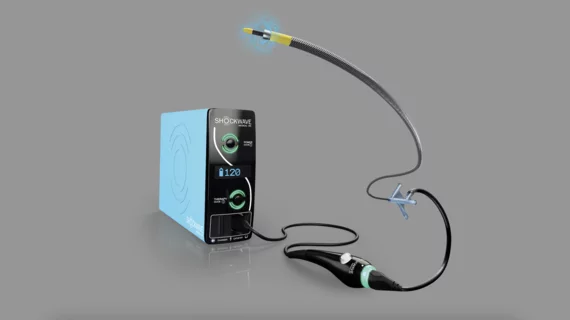Shockwave Medical’s IVL technology delivers more positive outcomes for PAD patients
Shockwave Medical, now a part of Johnson & Johnson MedTech, has been at the center of multiple late-breaking clinical sessions at VIVA 2024 in Las Vegas.
The company has had a quick rise to prominence thanks to the success of its intravascular lithotripsy (IVL) technology for breaking up severely calcified plaques in the coronary and peripheral arteries. In fact, Shockwave was acquired by Johnson & Johnson for approximately $13.1 billion in early 2024 after stringing together several clinical and policy victories.
Now, research teams are busy learning more about IVL, sharing their findings at healthcare conferences all over the world. The research presented at VIVA 2024 examined the impact of a new balloon-free catheter in addition to the safety and effectiveness of using IVL to treat a complex patient population.
New-look IVL catheter linked to positive data
First, a late-breaking presentation focused on the safety and effectiveness of Shockwave’s new Javelin Peripheral IVL Catheter in a total of 90 patients with heavily calcified, stenotic peripheral arterial lesions. The Javelin catheter does not have a balloon and features a 120-pulse lithotripsy emitter designed to help manage peripheral artery disease (PAD) patients with extremely narrowed blood vessels.
Overall, the catheter was associated with a technical acute procedural success rate of 99% and major adverse event rate of just 1.1% after 30 days. Only one complication occurred, and there were no reports of perforations, abrupt vessel closure, distal embolization or no-reflow.
“The outcomes were exactly what we have come to expect from IVL studies—a strong safety profile with the low final residual stenosis that physicians would hope to achieve,” principal investigator John D. Corl, MD, medical director of the PAD/CLI Program at The Lindner Center for Research and Education at The Christ Hospital, said in a prepared statement. “These new initial data are promising and pave the way for a new approach to the application of Shockwave IVL in our peripheral practices. With technologies now suited to safely address both crossable and uncrossable lesions, IVL has a unique opportunity to play an increasingly important role in optimizing outcomes for a wider set of patients with PAD.”
“We look forward to learning more about the performance of the Shockwave Javelin IVL catheter as we add to the ongoing trial follow-up data with a limited market release of the device in the coming months,” added Nick West, MD, Shockwave's chief medical officer.
Tracking the benefits of IVL in a complex patient population
The other VIVA 2024 late-breaker tracked 250 PAD patients with calcified peripheral lesions below the knee. All received treatment with the Shockwave Peripheral IVL System.
Overall, the study’s primary effectiveness endpoint—≤50% residual stenosis for all treated target lesions without serious angiographic complications after 30 days—was seen in 97.9% of patients. Meanwhile, major adverse limb events and post-treatment mortality at 30 days were both rare.
These findings were especially important, researchers explained, because the study’s population was much more complex than most clinical trials focused on PAD.
“Patients will now be followed in the study out to two years to assess the long-term durability of the compelling 30-day data in this difficult-to-treat patient population,” principal investigator Ehrin Armstrong, MD, interventional cardiologist and medical director of the Adventist Heart & Vascular Institute, explained in a statement.

